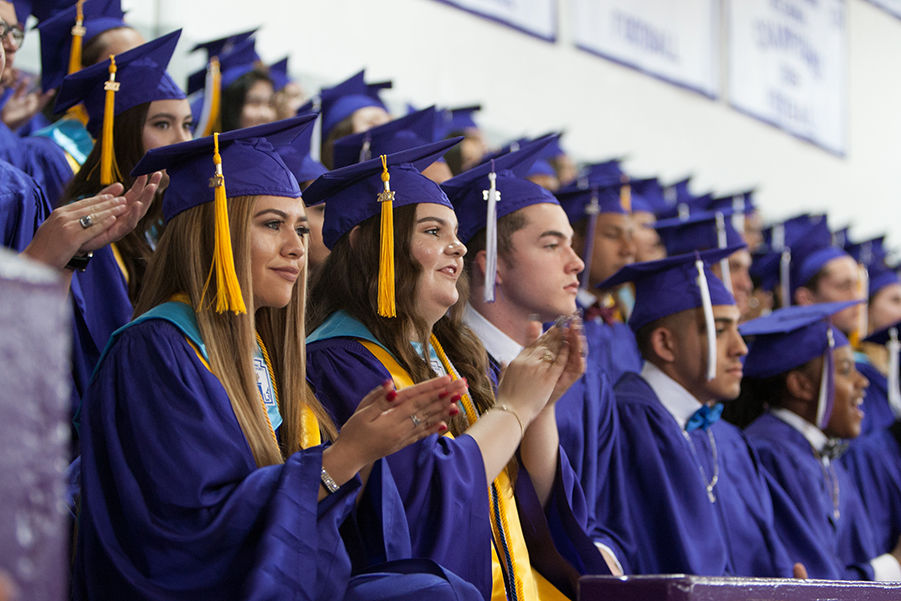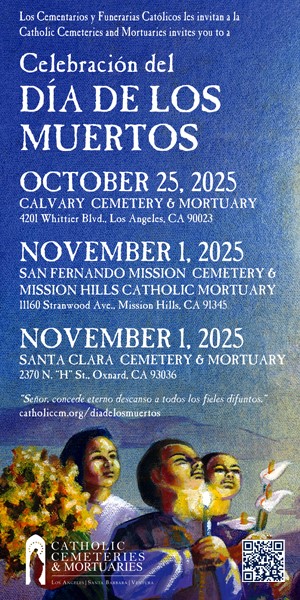Kevin Baxter prepared to attend the graduation ceremony at St. Pius X-St. Matthias Academy in Downey on May 26 full of hope and excitement. This graduating class was the first co-ed class in the history of a school formed from the merger of the all-boys’ school St. Pius X with the all-girls’ St. Matthias five years ago. The 2017 graduation is a success story for Catholic schools in the Archdiocese of Los Angeles.
And Baxter is an optimist by nature.
He is also superintendent of Catholic schools for the archdiocese and a board member of the National Catholic Education Association (NCEA). He is deeply involved in Catholic education at both the archdiocesan and national levels. Graduation season, brimming with student achievements and the successes of the school year, fills him with pride. It’s a time for looking back, but also for looking forward to ensure future success.
Baxter spoke with Angelus News about the state of Catholic schools and his optimism was evident. It is not a pie-in-the-sky optimism, but hope based on the hard work, innovative ideas, strong programs, good stewardship of resources, rigorous academic programs and on commitment to strong faith formation and Catholic identity.
“Faith formation remains our first and foremost priority in all of our schools,” he said. “If we’re not teaching the faith in an effective way, if we’re not forming students in the faith effectively, then we are failing at the most basic core level of what we do.” Focusing on catechetical formation of teachers at elementary and high school levels, and working with principals to ensure they see themselves as faith leaders of their school communities are key, according to Baxter.
A new innovation for school principals is a funder-supported program called Onward Leaders. This year the archdiocese had its first cohort of five “resident principals,” who worked with a master principal over the course of the year learning and training how to be a Catholic school principal. A program director “spent lots of time doing professional development for them and research, and educating them on all the aspects of being a principal,” he explained. All five have now been placed in schools where they’ll start as principals in the next school year.
“That’s really exciting, and we also have our second cohort just coming in, so we just identified five new resident principals for next year and they’ll be off to do that training,” he said. Baxter sees this as a long-term opportunity to fully develop leaders in the faith and academic excellence, and who can steward resources in an effective way.
Innovative ideas help to fuel growth and move Catholic schools toward a sustainable future.
One recently developed innovation is called Data Snapshot, which was put into use at the elementary level. Each school can access a data snapshot and get accurate real-time data for things such as academic performance data, enrollment data, demographic information and finance data.
“We thought this tool was really going to be most useful for schools...to see if they could get some funding support...but we find more and more schools are really interested in that data snapshot to use for prospective parents to come in and see how the school is doing,” said Baxter. “We want to move in a direction where we can transparently share our success and share how we’re doing as Catholic schools so people can see that growth, can see that great success that we’ve achieved.”
He also noted that it can identify areas of growth so focus can be placed on the areas where more time may need to be spent in order to continue to growing the school.
Dual-language immersion schools have become another innovation. All Souls in Alhambra opened in 2012 with both a Mandarin-English track and a Spanish-English track. “That continues to do very well. This year we’ve got two other schools, so we’ve got a total of three schools in operation. We’ve just identified three more schools that will be in operation for next year, so that will be six dual-language immersion schools,” Baxter said. He expects the archdiocese to have 20 dual-language immersion schools “within the next six years or so,” and sees these schools as an engine for growth due to tremendous parental and student interest.
With faith formation and quality leadership at the core, Baxter noted that finances, affordability and sustainability of schools are key aspects of their mission. “We have our strategy to achieve it, but how do we ensure that schools are both affordable and also that they’ve got the resources necessary to provide that high quality Catholic education to students and families?” he asked. “That’s essentially a lot of what we’re trying to think about and work on moving forward.”
He noted the continued importance of the Catholic Education Foundation (CEF) as well as other new initiatives, such as Onward Scholars, to provide scholarship assistance and other types of interventions to help kids achieve academically at high levels.
“We have to be willing to get out of our conventional thinking and try to seek ways to grow that will allow us to serve more students in the future,” he said. The archdiocese recently participated in a five-city market research study by the NCEA to better understand why parents choose Catholic schools or why they may not be doing so. Those research results are expected in the very near future.
“That might help inform us a little bit here in Los Angeles about how to best approach families who might be considering Catholic schools, so that’s another thing that NCEA is doing that’s pretty exciting,” said Baxter.
Baxter noted that the greater Los Angeles area is blessed with a burgeoning population, with a large percentage coming from Mexico or Latin America as well as Asian or Pacific Islanders. A large percentage of this population is also Catholic, and growth in the ability to serve these populations is a great opportunity to grow the Catholic schools, he said.
“Across the country we’re seeing upward trends in regards to Latino students,” he added. Statistics for the recently concluded school year he provided paint a picture of the diversity of students in Los Angeles’ Catholic schools: in elementary schools about 47 percent are Latino and 10 percent are Asian/Pacific Islander, with 83 percent of students being Catholic. In the 51 Catholic high schools in the archdiocese, 37 percent of students are Latino, about 14 percent are Asian/Pacific Islander, and overall 70 percent of the students are Catholic.
“I feel incredibly blessed to be in this archdiocese because I do feel like our kind of inherent demographics are very strong and very solid and a lot of it is going to depend on the work we do to ensure that Catholic schools have all those components of success,” Baxter said. “If we do those things in a really high quality, highly rigorous way we have great potential to grow significantly with enrollment and to create sustainability in more and more of our schools.
“I am overall very optimistic about our direction and about where we are headed,” he added, “and I feel good about where our Catholic schools are.”

